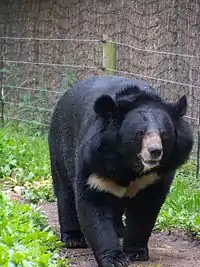< Reconstruction:Proto-Sino-Tibetan

Reconstruction:Proto-Sino-Tibetan/d-wam
Proto-Sino-Tibetan
Etymology
- Proto-Sino-Tibetan: *dɣwjəm (Coblin, 1986)
- Proto-Tibeto-Burman: *d-wam (Matisoff, STEDT; Benedict, 1972; Weidert, 1987); *d-wam(*A) (Coblin, 1986); *d-wɑm (Chou, 1972)
Old Chinese had *-m final, as suggested by Shuowen (炎 (yán) - phonetic), which is preserved only in a few Min dialects, e.g. Amoy, Fu'an, Yong'an; elsewhere the final changed mainly to -ŋ.
Other languages in East Asia have words which look similar to the OC form: Korean 곰 (gom, “bear”), Japanese くま (kuma); also, compare Proto-Mon-Khmer *[k]mum (“bear, black bear”) (Mon ကၟဳ (mɛm), Khmer ឃ្មុំ (kmum) (as in ខ្លាឃ្មុំ (klaa kmum, “sun bear”))), Vietnamese hùm (“tiger”).

The Asian black bear (Ursus thibetanus), whose habitat was probably one of the closest to the Proto-Sino-Tibetan Urheimat, hence the species that this PST root might have originally referred to.
Descendants
- Old Chinese: 熊 /*C.ɢʷəm/ (B-S) /*ɢʷlɯm/ (ZS) (“bear”)
- Himalayish
- Tibeto-Kanauri
- Bodic
- Tibetan
- Written Tibetan: དོམ (dom, “bear”)
- Tibetan
- Bodic
- Tibeto-Kanauri
- Tangut-Qiang
- Northern Tangut
- Tangut: 𗴈 (*dow²) /dõ³⁵/
- rGyalrongic
- Situ: təwam /təwaʔm/
- Northern Tangut
- Lolo-Burmese-Naxi
- Proto-Karen: *thamᴬ (Luangthongkum, 2013)
- Proto-Kuki-Chin: *wom
- Khomic
- Khumi Chin: tävawng
- Khomic
This article is issued from Wiktionary. The text is licensed under Creative Commons - Attribution - Sharealike. Additional terms may apply for the media files.